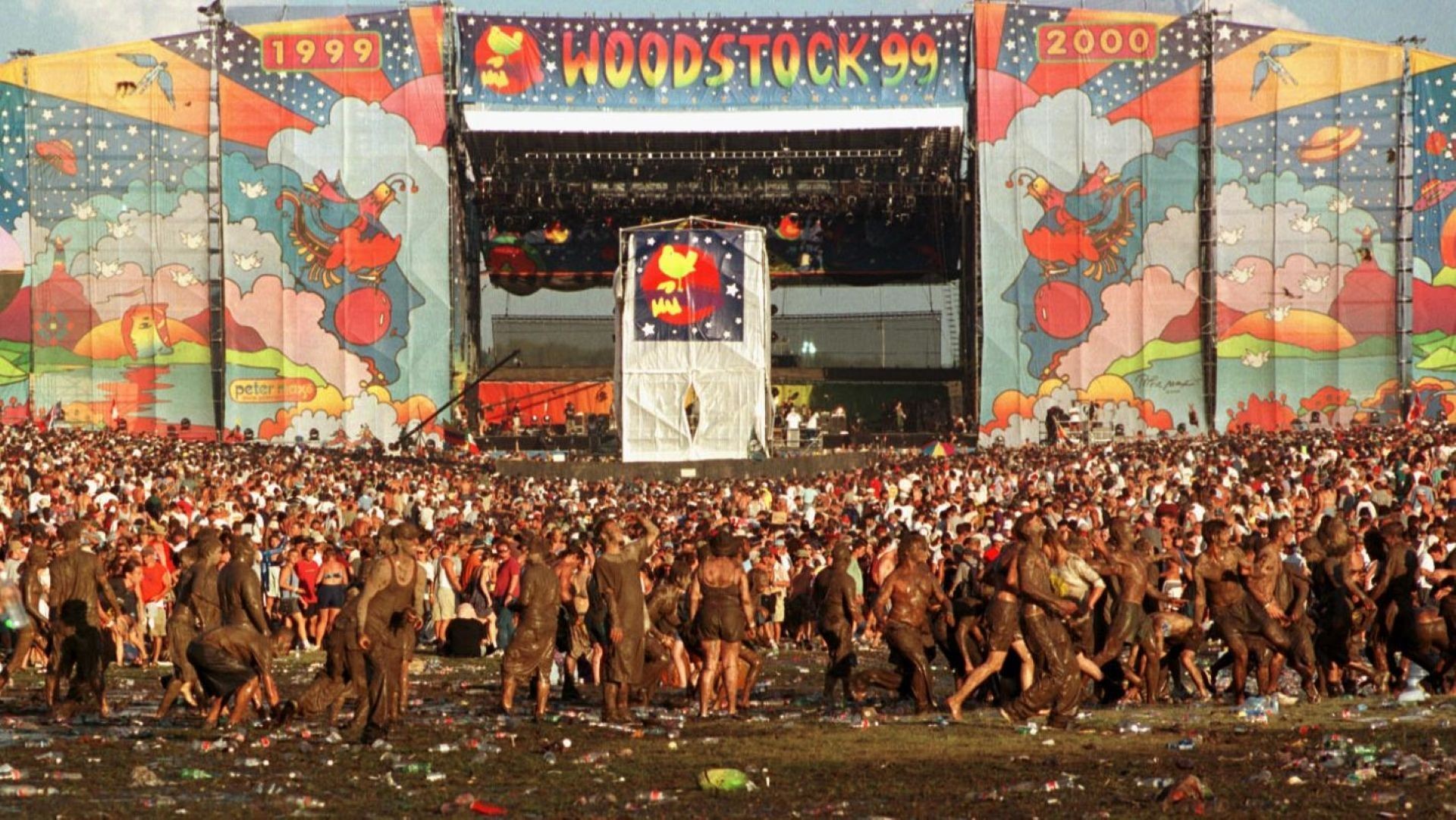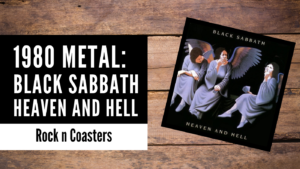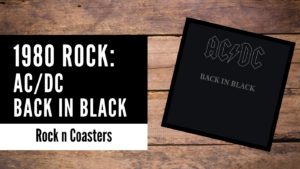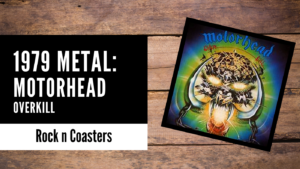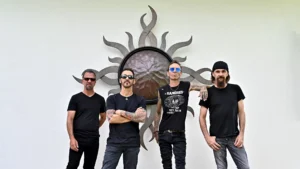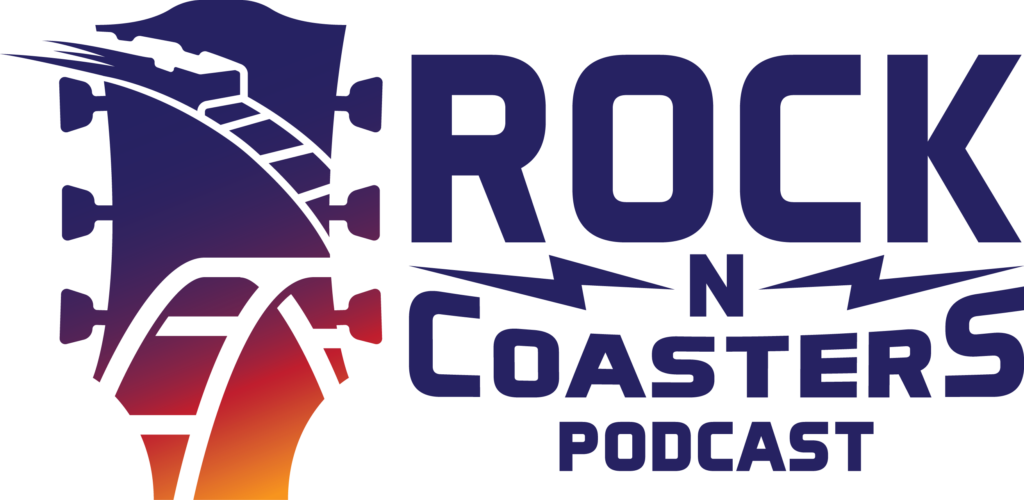Netflix just dropped documentary about the disastrous Woodstock 99 Music Festival and it brings up some interesting questions. This is not the first doc about the calamitous festival as HBO presented theirs last year. Trainwreck previously known as Clusterfuck has a distinctive advantage over the HBO doc because the series consists of three episodes structured to mirror the three days of the actual festival.
If you are a fan of this podcast, you know that we love music festivals and when Robert saw this one come up in the press a couple months ago, under the previous name, we knew we would have to review it here on the show. In this episode we will layout the series, give our review and discuss what we, as a society, music festival goers and fans can learn from the events of Woodstock 99. Let’s kick it off.
Hello and welcome to the Rock n Roller podcast, I am Michele, and I am Robert and here we talk about our love of music, travel, and roller coasters. On today’s show we are going to discuss the Woodstock 99 documentary, Trainwreck that you can watch on Netflix—and want to warn you right off the bat there are plenty of spoilers in this episode, if that matters to you, pause right here, go watch it and come back and listen. So, I am going to break it down and Robert will join us later to give his thoughts.
The Godfather of Soul and Music Festival Royalty
The opening sequence of episode one features real footage of the festival grounds on the Monday morning after the festival. It looks like a warzone. A lot of documentaries and podcast do this now and give the viewer/listener a forecasted view of the ending and then work their way backward to arrive at the beginning of the story. Of course, we have all heard the stories of the festival disaster, but this doc starts off with pure carnage.
Early in episode one and through episode two it is structured with some focus by giving the viewer constant countdowns to remind us that scary as things might seem so far, they can only get worse. If we can set the scene just a bit, most people know about the peace and hippy love fest of the original Woodstock in 1969 and the disastrous attempt in 94 and quickly in this doc we meet Michael Lang, who was the man behind the original music festival and had lofty goals of brining the 30th anniversary show back bigger and better. Right off the bat we see things are much different but I need to remind you that Woodstock 69 was no walk in the park. There were too many people, too many drugs, a heck of a lot of mud and other problems that occurred in the 94 rendition too. But 99 would be different, right? To start off they decided on a de-commissioned Air Force base that had more than eight miles of space, huge tarmacs, and runways, even a fire station, airplane hangars and more. But one thing is clear, early in this documentary, that this festival was designed to be a money maker. Aren’t they all?
Aside from Lang, there were some heavy hitters in the music and festival promotion game that were a part of this festival and by all rights they wanted to produce the most epic three-day event possible, but it quickly got out of hand. One of the first scenes is James Brown refusing to go on stage because he wants to be paid in full before his performance. This set the scene that cost cutting measures were afoot. We then see Sheryl Crow, The Offspring and others play throughout the first day with the closing act, Korn playing to a massive crowd of more than 250,000 people. You could see the energy that was building, and Jonathan Davis said in his interview, it’s better than any drug when you have that many people in the palm of your hand. The first day, and the first episode ended with a scene of the rave after-party where 60,000 people packed into an airplane hangar to a naked, drug fueled musical ecstasy. As the cliffhanger approached, we knew that there were worse things to come in the following two days.
Break Stuff
There is an effort made to understand why things might have gotten out of hand on day one and the Korn performance, but it was the deliberate finger-pointing in the direction of Limp Bizkit’s Fred Durst by the documentarians that fueled the crowd’s rage on Saturday night. One of the journalists equates it to the culture of 1999 that is brimming with sexuality and testosterone fueled angst by an entire generation of “crazed frat boys.” But there is more to that story. This festival was just down right poorly planned. It was not 1969. Society and music had changed right Robert?
[Robert] yes, you must remember that anytime you watch a documentary you are seeing it through the filmmaker’s eyes. Jamie Crawford had a story to tell and the three of four acts that fit that narrative were showcased, namely Sherly Crow and Jewel because of the salacious attempts at male domination along with Korn, Limp Bizkit, Bush, Kid Rock, and the Red Hot Chili Peppers who we will get to later in the show. But there were so many acts playing. We have a full list in our show notes. Namely, there is no mention of Metallica, Ice Cube, Rage Against the Machine, Godsmack, Everlast, and even low-key acts like Alanis Morrisette, Creed, Moby, Live, and Muse. You are right music was at a turning point in 99 and this festival showcased that.
[Michele] Back to episode two… The footage of the concertgoers tearing down the structures remains as powerful today as it was then. It was like watching a zombie movie without CGI. It was real and in your face. Central to episode two was the rave after-party featuring Fat Boy Slim, (real name, Norman Smith) recalls seeing a van rambling through the crowd and recalls the horrific story of a young girl who was sexually assaulted. Smith recounts in somber reality, he says, “in the midst of all those people having fun and me wanting to make everybody love each other, that was going on under our noses.”
The issue of sexual assault is otherwise handled as almost an afterthought, towards the end of Episode three. Woodstock original organizer Michael Lang even says that he didn’t hear about any reports of sexual assault until after the festival was over. “You can’t vet the people who buy your tickets — you just can’t,” he bemoans at one point.
Episode three is much the same—nudity, teenage angst, and rebellion up until the Chili Peppers hit the stage and then all hell broke loose. Through rose-colored glasses of yesteryear, the promoters thought it would be a good idea to pass out 100,000 candles—remind you that this is way before everyone had a flashlight on their iPhone, and asked if Anthony Kiedis could calm the crowd down as they hit the stage for their encore. Of course, a happy ending didn’t fit the narrative of this doc or actual history, and the Chili Peppers came out and sang Jimi Hendrix’s Fire as the crowd literally set the venue on fire! What ensued was almost a half hour of carnage in the documentary as the festival became the gates of hell. The all-out riot included torching tractor-trailers, breaking into the vendor area including looting and stealing from ATMs, and tearing down the massive “art wall” fence and the quelling by storm-trooper-riot-police.
The Nightmare of Woodstock 99
[Michele] The nightmare of Woodstock 99 occurred for a multitude of reasons, from incredibly poor event planning that led to contaminated drinking water on sight and 18-year-olds being hired to work security, to what can happen when a young, adrenaline-fueled crowd drinks, does drugs, and rocks out hard for three days straight, Woodstock ’99 descended into a full-scale violent insurrection. The aftermath included 44 arrests, eight reported instances of sexual assault (including four rapes), and overall, a dark moment for festival culture as we know it.
While the runtime of Trainwreck is longer than HBO’s take, the number of artists spoken to is somehow smaller, though Jewel, Gavin Rossdale, and Fatboy Slim are featured prominently, talking openly about the vibes of the experience and why, for example, Jewel left the stage deeply disturbed by playing for a crowd actively calling for a glimpse of her breasts. While some of the voices are similar to the HBO doc, MTV’s Ananda Lewis makes a big impression with her talking head segments, delivering some of Trainwreck‘s most pithy commentary.
The “victims” were easy-to-mock millennial influencers, the main “villain,” Billy McFarland, was arrested for various crimes, and most importantly no one got seriously injured. Woodstock ’99, though, was more than a trainwreck; for many people who went, it was legitimately traumatic.
The Verdict
Trainwreck thus has the good taste to save its moments of ecstasy for the festival organizers: When talking-head interview subjects ask, “How could this have happened?” the filmmakers immediately follow it up with a “One Year Earlier…” flashback which answers the question.
[Robert] It is a bleak look at humanity, at least in the eyes of the filmmaker. The doc clearly shows the behind-the-scenes issues that exacerbated the situation, but it also shows the true power and energy of a massive music festival. It is no surprise that some of those that attended said that their time at Woodstock 99 was a life changing moment and it wasn’t all negative.
[Michele] So Robert what did can we learn from this documentary and music festivals today?
[Robert] I have been to at least 500 concerts in my life and many music festivals. I even played in two of these huge festivals with my little band Rainmaker, right around the time of Woodstock 99. I played third stage at the Summerset Festival in Wisconsin and a “birthday bash” in Tampa, Florida with many of these same acts as this festival.
The point is, aside from burning down the place, pretty much everything you see in this doc was prevalent at any music festival at the time. If you remember Michele, the first time we went to Louder Than Life in Louisville, I said, this isn’t the music festival of yesterday. Here they had gourmet food, bourbon tasting and fancy exhibits.
The thing is, I believe that music festival promoters today, in particular Danny Wimmer Presents who in my opinion is the best in the business, have learned from many of the mistakes of Woodstock. And music festivals continue to evolve. Especially the DWP ones. Think about how Welcome to Rockville has changed. When we went it was much like the set-up of Woodstock 99 as the whole festival was in the parking lot of an NFL stadium. They since moved to the Daytona Speedway, as that being one of the reasons.
Even today, music festivals, especially rock n roll ones, are not for the faint-hearted. They are still overbearingly hot. We have attended Bourbon and Beyond and Louder Than Life when it was more than 100 degrees. There is almost no shade. The festivals are notoriously expensive and very strict on what you can bring in. All of these are examples of changes post-Woodstock 99 and of course the more recent violence and shootings at several large shows.
There is a reason why we pay the VIP Passes. At least there you might find some shade, decently clean porta-potties and maybe even a place to sit down.
My take as to what did we learn? I do believe that some of the story is correct in the film that it was fueled by angst and greed but that is only half the of the story. Whenever you get 250,000 people in one place at one time you are bound to have situations like this. There is no way that you can contain the frenzy of that many people with the small attempts at security. It just isn’t possible. I think, like I said a moment ago that the festival experience will continue to get better, especially with the folks like DWP at the helm. As Korn’s Jonathan Davis said late in the film, it is the promoter’s primary job to keep everyone safe. I think that they have learned their lesson and just look at how DWP handled this year’s Rockville and you will see what I am saying.
Michele what are your thoughts as to what we learned from this doc and music festivals as a whole?
[Robert] So, before we close, Michele would you give Trainwreck on Netflix a thumbs up, thumbs down or thumbs sideways?
[Robert] I give it a thumbs sideways. I will agree that what happened at Woodstock 99 is atrocious, I think that the filmmakers told a story to fit their narrative. I will let the viewers decide what they think.
[Michele] So guys, what do you think? Did you watch Trainwreck? What are your thoughts and what can we learn from it? Let us know in the comments or on socials, just search Rock n Coasters.
Where to Watch: Trainwreck: Woodstock ’99 is streaming now on Netflix.
Trainwreck Official Trailer
Woodstock 99 Line-up
Thursday 22nd July
West Stage
- Frostbit Blue
- KJ James
- Little Big Jam
- Gridley Paige
- Djoliba
- Red Herring
- Rattlebasket
- In Bloom
- Flipp
- 3rd Bass
- Vertical Horizon
- Strangefolk
- G Love and Special Sauce
- The String Cheese Incident
- Bernie Worrell and the Woo Warriors
- George Clinton & the P-Funk All-Stars
AMP3.com Emerging Artists Stage
- Immoral Fibres
- Simmi
- Chris Glenn
- Gary Durdin & The Clay Pinps
- Johnny Rushmore
Friday 23 June
East Stage
- James Brown
- G Love and Special Sauce
- Jamiroquai
- Live
- Sheryl Crow
- DMX
- The Offspring
- Korn
- Bush
West Stage
- Spitfire
- Oleander
- The Umbilical Brothers
- moe.
- Lit
- Buckcherry
- The Roots
- Insane Clown Posse
- George Clinton & the P-Funk All-Stars
Emerging Artists Stage
- FoN
- Linda Rutherford & Celtic Fire
- Sugar Daddy
- Sticky Pistil
- Bijou Phillips
- Mike Errico
- King Konga
- Ben Lee
- Beth Hart Band
- Liars
- Chris Pérez Band
- Sherri Jackson
- Chris McDermott
- Moby
Saturday 24th July
East Stage
- The Tragically Hip
- Kid Rock
- Wyclef Jean with the Refugee Allstars
- Counting Crows
- Dave Matthews Band
- Alanis Morissette
- Limp Bizkit
- Rage Against the Machine
- Metallica
West Stage
- Spitfire
- Guster
- Bruce Hornsby
- Everclear
- Ice Cube
- Los Lobos
- Mickey Hart/Planet Drum
- The Chemical Brothers
Emerging Artists Stage
- Young & Fabulous!
- Gargantua Soul
- 3
- Serial Joe
- American Pearl
- Full Devil Jacket
- Old Pike
- Strangefolk
- DDT
- 2 Skinee J’s
- Gigolo Aunts
- Fatboy Slim
Sunday 25th July
East Stage
- Willie Nelson
- The Brian Setzer Orchestra
- Everlast
- Elvis Costello
- Jewel
- Creed, featuring Robby Krieger
- Red Hot Chili Peppers
West Stage
- Spitfire
- Mike Ness
- Our Lady Peace
- Rusted Root
- Sevendust
- Collective Soul
- Godsmack
- Megadeth
Emerging Artists Stage
- Kirsti Gholson
- Moe Loughran
- The Scoldees
- The Supersuckers
- Stormy Mondays
- Big Sugar
- Muse
- John Oszajca
- Pound
- Pushmonkey
- Cyclefly
- Indigenous
- John Entwistle
- Reveille
 20 Top Music Festival Packing List Items For 2022 And What NOT To Bring
20 Top Music Festival Packing List Items For 2022 And What NOT To Bring
Music festivals are an awesome way to spend time jamming with your friends and maybe even exploring a new part of the world.
Festivals come in all shapes and sizes, with the music of all types, ranging from indie rock, classic rock, and world music to hip hop, jazz, Americana, and bluegrass. Be prepared for this year’s lineup of festivals by checking out this go-to festival packing list, including what to wear at music festivals, what NOT to bring, and other FAQs.
